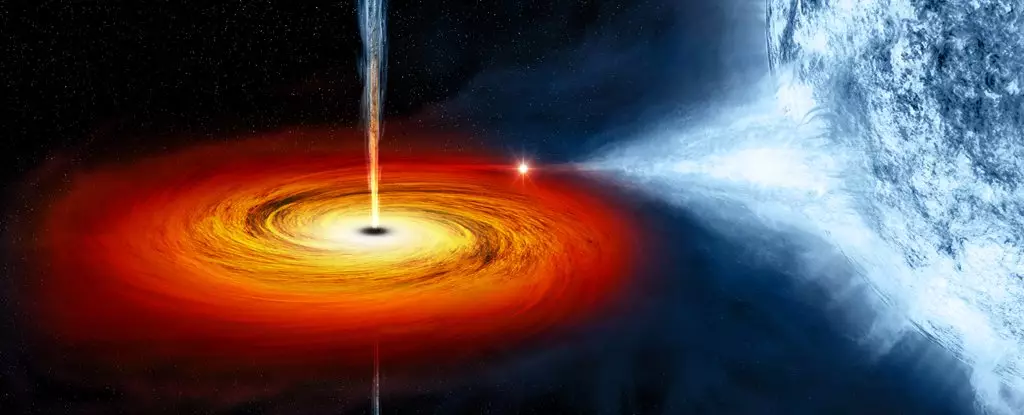The investigation of high-energy gamma rays has long taken scientists on a journey filled with intrigue and insights into the universe’s most powerful phenomena. Traditionally, these potent rays were attributed to distant quasars—a phenomenon rooted in the chaotic feeding habits of supermassive black holes situated in the centers of galaxies. However, recent findings have challenged these assumptions by revealing an unexpected source of extreme gamma radiation much closer to home: the microquasar V4641 Sagittarii.
V4641 Sagittarii is located approximately 20,000 light-years from Earth in the direction of the constellation Sagittarius. This relatively close distance, when set against the vastness of the universe, underscores the potential significance of V4641 Sagittarii in our cosmic understanding. Contrary to previous assumptions that high-energy gamma rays predominantly emanate from quasars, this microquasar has demonstrated that intense gamma-ray emissions can also arise from smaller-scale cosmic systems. The black hole at the center of V4641 Sagittarii—estimated to have a mass six times that of our Sun—actively consumes material from a massive companion star approximately three solar masses in size.
It is this dynamic interaction that produces astonishing radiation outputs akin to those observed in larger quasars, which has now upended long-held beliefs regarding the scale at which such high-energy emissions can occur.
The gamma rays detected from V4641 Sagittarii have shattered expectations by reaching energy levels of up to 200 teraelectronvolts (TeV). This figure is staggering, as it reflects energies 200 trillion times greater than visible light—placing these emissions among the highest-energy photons detected in space. Such findings highlight the intricate and powerful interactions occurring within this microquasar, revealing that V4641 Sagittarii has the capacity to produce gamma rays at energies previously associated only with more massive and distant quasars.
Sabrina Casanova, a researcher from the Institute of Nuclear Physics Polish Academy of Sciences, pointed out the usual energy parameters of microquasars—typically a mere tens of gigaelectronvolts. In this light, the emissions recorded from V4641 Sagittarii mark a groundbreaking revelation, indicating that smaller cosmic systems could engage in similarly robust radiation processes once believed exclusive to their larger counterparts.
The extraordinary wealth of data concerning V4641 Sagittarii has primarily come from the High-Altitude Water Cherenkov (HAWC) observatory based on the slopes of the extinct Sierra Negra volcano in Mexico. The observatory’s design is ingeniously tailored to capture high-energy particles as they shed light upon the cosmic landscape. With an array of 300 large tanks containing purified water, the facility detects the flash of light known as Cherenkov radiation—created when high-energy particles break through water at speeds exceeding that of light. This phenomenon enables scientists to deduce not only the nature of the particles but also the sources from whence they originated.
Operating with a broad view, HAWC can monitor 15 percent of the sky at any given moment, and it meticulously maps out two-thirds of the entire celestial sphere every 24 hours. This effective scanning strategy is crucial, as it allows researchers to identify luminous regions within the cosmic milieu, as demonstrated in the identification of V4641 Sagittarii—a previously unrecognized hotspot of gamma-ray emissions.
The newfound perception of V4641 Sagittarii’s capabilities invites deep reflection on the nature of cosmic radiation and microquasars themselves. Previous observations of microquasars have revealed emissions that typically peaked around levels of 25 TeV; however, V4641 Sagittarii has been shown to produce gamma radiation on par with that generated by full-fledged quasars, demonstrating that the physical processes involved might not be so different after all.
This has significant implications for astrophysics; microquasars can serve as natural laboratories, operating on timescales of mere days compared to the extensive timelines associated with massive quasars. This accelerates research possibilities, allowing scientists to experiment with and refine their understanding of the physics that govern our universe.
The achievements of V4641 Sagittarii and the capabilities of observatories such as HAWC mark a pivotal moment in the study of high-energy astrophysics. As data continues to accumulate, scientists are poised to redefine their grasp on the complexities of cosmic environments and the mechanisms behind high-energy emissions. The revelation of a microquasar emitting such significant radiation expands the boundaries of our understanding and serves as a stepping stone for future investigations into the nature of the cosmos, offering a dynamic glimpse into the universe’s lesser-known yet equally remarkable wonders.


Leave a Reply